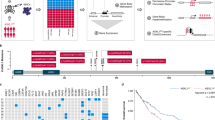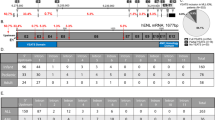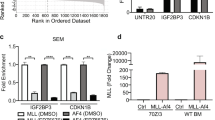Abstract
Previously, we identified SETD2 loss-of-function mutations in 22% of MLL-rearranged (MLLr) acute leukemia patients, implicating a mechanism for cooperativity between SETD2 mutations and MLL fusions. However, the detailed mechanism of how SETD2-H3K36me3 downregulation accelerates MLLr leukemia remains unclear. Here, we show that in MLLr leukemia, both H3K79me2 and H3K36me3 are aberrantly elevated and co-enriched in a group of genes. SETD2 inactivation leads to a global reduction of H3K36me3 and a further elevation of H3K79me2, but does not change the expression of known MLL fusion target genes. Instead, this pattern of histone changes is associated with transcriptional deregulation of a novel set of genes; downregulating tumor suppressors (for example, ASXL1) and upregulating oncogenes (for example, ERG). Taken together, our findings reveal a global crosstalk between the oncogenic DOT1L-H3K79me2 axis and the tumor suppressive SETD2-H3K36me3 axis in gene regulation, provide molecular insights into how SETD2 mutations accelerate MLLr leukemogenesis through differential regulation of additional tumor suppressors and oncogenes.
This is a preview of subscription content, access via your institution
Access options
Subscribe to this journal
Receive 12 print issues and online access
$259.00 per year
only $21.58 per issue
Buy this article
- Purchase on Springer Link
- Instant access to full article PDF
Prices may be subject to local taxes which are calculated during checkout





Similar content being viewed by others
References
Wagner EJ, Carpenter PB . Understanding the language of Lys36 methylation at histone H3. Nat Rev Mol Cell Biol 2012; 13: 115–126.
Dalgliesh GL, Furge K, Greenman C, Chen L, Bignell G, Butler A et al. Systematic sequencing of renal carcinoma reveals inactivation of histone modifying genes. Nature 2010; 463: 360–363.
Duns G, van den Berg E, van Duivenbode I, Osinga J, Hollema H, Hofstra RMW et al. Histone methyltransferase gene SETD2 is a novel tumor suppressor gene in clear cell renal cell carcinoma. Cancer Res 2010; 70: 4287–4291.
Li J, Duns G, Westers H, Sijmons R, van den Berg A, Kok K . SETD2: an epigenetic modifier with tumor suppressor functionality. Oncotarget 2016; 7: 50719–50734.
Zhu X, He F, Zeng H, Ling S, Chen A, Wang Y et al. Identification of functional cooperative mutations of SETD2 in human acute leukemia. Nat Genet 2014; 46: 287–293.
Mar BG, Bullinger LB, McLean KM, Grauman PV, Harris MH, Stevenson K et al. Mutations in epigenetic regulators including SETD2 are gained during relapse in paediatric acute lymphoblastic leukaemia. Nat Commun 2014; 5: 3469.
Andersson AK, Ma J, Wang J, Chen X, Gedman AL, Dang J et al. The landscape of somatic mutations in infant MLL-rearranged acute lymphoblastic leukemias. Nat Genet 2015; 47: 330–337.
Li J, Moazed D, Gygi SP . Association of the histone methyltransferase Set2 with RNA polymerase II plays a role in transcription elongation. J Biol Chem 2002; 277: 49383–49388.
Kizer KO, Phatnani HP, Shibata Y, Hall H, Greenleaf AL, Strahl BD . A novel domain in Set2 mediates RNA polymerase II interaction and couples histone H3 K36 methylation with transcript elongation. Mol Cell Biol 2005; 25: 3305–3316.
Bannister AJ, Schneider R, Myers FA, Thorne AW, Crane-Robinson C, Kouzarides T . Spatial distribution of di- and tri-methyl lysine 36 of histone H3 at active genes. J Biol Chem 2005; 280: 17732–17736.
Guenther MG, Levine SS, Boyer LA, Jaenisch R, Young RA . A chromatin landmark and transcription initiation at most promoters in human cells. Cell 2007; 130: 77–88.
Jonkers I, Lis JT . Getting up to speed with transcription elongation by RNA polymerase II. Nat Rev Mol Cell Biol 2015; 16: 167–177.
Steger DJ, Lefterova MI, Ying L, Stonestrom AJ, Schupp M, Zhuo D et al. DOT1L/KMT4 recruitment and H3K79 methylation are ubiquitously coupled with gene transcription in mammalian cells. Mol Cell Biol 2008; 28: 2825–2839.
Wang QF, Wu G, Mi S, He F, Wu J, Dong J et al. MLL fusion proteins preferentially regulate a subset of wild-type MLL target genes in the leukemic genome. Blood 2011; 117: 6895–6905.
Bernt KM, Zhu N, Sinha AU, Vempati S, Faber J, Krivtsov AV et al. MLL-rearranged leukemia is dependent on aberrant H3K79 methylation by DOT1L. Cancer Cell 2011; 20: 66–78.
Okada Y, Feng Q, Lin Y, Jiang Q, Li Y, Coffield VM et al. hDOT1L links histone methylation to leukemogenesis. Cell 2005; 121: 167–178.
Deshpande AJ, Deshpande A, Sinha AU, Chen L, Chang J, Cihan A et al. AF10 regulates progressive H3K79 methylation and HOX gene expression in diverse AML subtypes. Cancer Cell 2014; 26: 896–908.
Gelsi-Boyer V, Trouplin V, Adelaide J, Bonansea J, Cervera N, Carbuccia N et al. Mutations of polycomb-associated gene ASXL1 in myelodysplastic syndromes and chronic myelomonocytic leukaemia. Br J Haematol 2009; 145: 788–800.
Micol JB, Duployez N, Boissel N, Petit A, Geffroy S, Nibourel O et al. Frequent ASXL2 mutations in acute myeloid leukemia patients with t(8;21)/RUNX1-RUNX1T1 chromosomal translocations. Blood 2014; 124: 1445–1449.
Grossmann V, Tiacci E, Holmes AB, Kohlmann A, Martelli MP, Kern W et al. Whole-exome sequencing identifies somatic mutations of BCOR in acute myeloid leukemia with normal karyotype. Blood 2011; 118: 6153–6163.
Tsuzuki S, Taguchi O, Seto M . Promotion and maintenance of leukemia by ERG. Blood 2011; 117: 3858–3868.
Koskela HL, Eldfors S, Ellonen P, van Adrichem AJ, Kuusanmaki H, Andersson EI et al. Somatic STAT3 mutations in large granular lymphocytic leukemia. N Engl J Med 2012; 366: 1905–1913.
Audrito V, Serra S, Brusa D, Mazzola F, Arruga F, Vaisitti T et al. Extracellular nicotinamide phosphoribosyltransferase (NAMPT) promotes M2 macrophage polarization in chronic lymphocytic leukemia. Blood 2015; 125: 111–123.
Medyouf H, Gusscott S, Wang H, Tseng JC, Wai C, Nemirovsky O et al. High-level IGF1R expression is required for leukemia-initiating cell activity in T-ALL and is supported by Notch signaling. J Exp Med 2011; 208: 1809–1822.
Lavallee VP, Baccelli I, Krosl J, Wilhelm B, Barabe F, Gendron P et al. The transcriptomic landscape and directed chemical interrogation of MLL-rearranged acute myeloid leukemias. Nat Genet 2015; 47: 1030–1037.
Patel JP, Gonen M, Figueroa ME, Fernandez H, Sun Z, Racevskis J et al. Prognostic relevance of integrated genetic profiling in acute myeloid leukemia. N Engl J Med 2012; 366: 1079–1089.
Bejar R, Stevenson K, Abdel-Wahab O, Galili N, Nilsson B, Garcia-Manero G et al. Clinical effect of point mutations in myelodysplastic syndromes. N Engl J Med 2011; 364: 2496–2506.
Abdel-Wahab O, Adli M, LaFave LM, Gao J, Hricik T, Shih AH et al. ASXL1 mutations promote myeloid transformation through loss of PRC2-mediated gene repression. Cancer Cell 2012; 22: 180–193.
Baldus CD, Burmeister T, Martus P, Schwartz S, Gokbuget N, Bloomfield CD et al. High expression of the ETS transcription factor ERG predicts adverse outcome in acute T-lymphoblastic leukemia in adults. J Clin Oncol 2006; 24: 4714–4720.
Thoms JA, Birger Y, Foster S, Knezevic K, Kirschenbaum Y, Chandrakanthan V et al. ERG promotes T-acute lymphoblastic leukemia and is transcriptionally regulated in leukemic cells by a stem cell enhancer. Blood 2011; 117: 7079–7089.
Tursky ML, Beck D, Thoms JA, Huang Y, Kumari A, Unnikrishnan A et al. Overexpression of ERG in cord blood progenitors promotes expansion and recapitulates molecular signatures of high ERG leukemias. Leukemia 2015; 29: 819–827.
Loughran SJ, Kruse EA, Hacking DF, de Graaf CA, Hyland CD, Willson TA et al. The transcription factor Erg is essential for definitive hematopoiesis and the function of adult hematopoietic stem cells. Nat Immunol 2008; 9: 810–819.
Stankiewicz MJ, Crispino JD . ETS2 and ERG promote megakaryopoiesis and synergize with alterations in GATA-1 to immortalize hematopoietic progenitor cells. Blood 2009; 113: 3337–3347.
Pereira DS, Dorrell C, Ito CY, Gan OI, Murdoch B, Rao VN et al. Retroviral transduction of TLS-ERG initiates a leukemogenic program in normal human hematopoietic cells. Proc Natl Acad Sci USA 1998; 95: 8239–8244.
Acknowledgements
This work was supported by the National Natural Science Foundation of China (grant 81425003 and 91731302 to QFW, grant 81500142 to AC), the Strategic Priority Research Program of the Chinese Academy of Sciences (grant XDA12010304 to QFW), the CFK (to GH), National Institutes of Health (NIH) (R21CA187276 to GH), the scholarship from China Scholarship Council (No. 201504910521 to JB), the Youth Innovation Promotion Association of Chinese Academy of Sciences (to FH), the Suzhou Key Laboratory for Pediatric Leukemia (SZS201615), Social Development Project of Jiangsu Province (CXTDA2017014 to SH), the Uehara Memorial Foundation for a Research Fellowship (to YH). We thank Dr Tao Cheng (Chinese Academy of Medical Sciences and Peking Union Medical College) for generously providing the Setd2 shRNAs.
Author contributions
QFW and GH designed the research; JB performed all the experiments and bioinformatics analysis; AC, XY, YD, Y-LZ, DZ, PL, YH, YZ, ZX helped with experiments; FH, JH and YS helped with bioinformatics analysis; JB, HLG, QFW and GH wrote the manuscript.
Author information
Authors and Affiliations
Corresponding authors
Ethics declarations
Competing interests
The authors declare no conflict of interest.
Additional information
Supplementary Information accompanies this paper on the Leukemia website
Supplementary information
Rights and permissions
About this article
Cite this article
Bu, J., Chen, A., Yan, X. et al. SETD2-mediated crosstalk between H3K36me3 and H3K79me2 in MLL-rearranged leukemia. Leukemia 32, 890–899 (2018). https://doi.org/10.1038/leu.2017.339
Received:
Revised:
Accepted:
Published:
Issue Date:
DOI: https://doi.org/10.1038/leu.2017.339
This article is cited by
-
RNA m6A methylation and regulatory proteins in pulmonary arterial hypertension
Hypertension Research (2024)
-
Tumor-suppressive functions of protein lysine methyltransferases
Experimental & Molecular Medicine (2023)
-
Histone modifications during the life cycle of the brown alga Ectocarpus
Genome Biology (2021)
-
Recurrent SETD2 mutation in NPM1-mutated acute myeloid leukemia
Biomarker Research (2020)
-
SETD2 mutations confer chemoresistance in acute myeloid leukemia partly through altered cell cycle checkpoints
Leukemia (2019)



